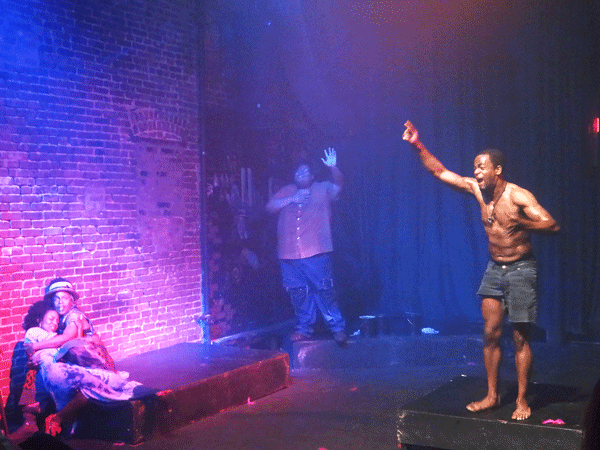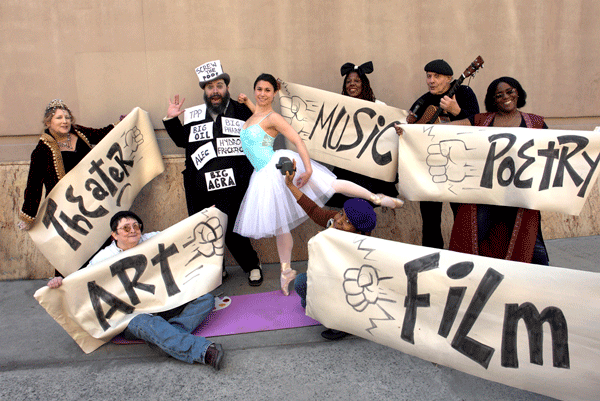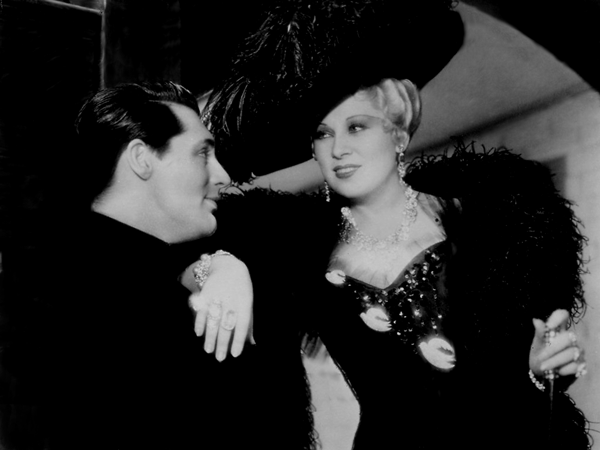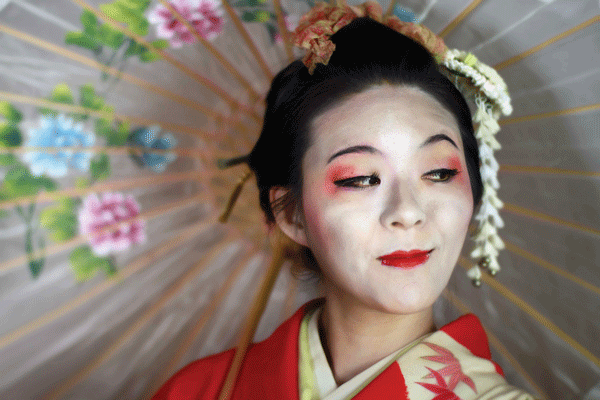
BY SCOTT STIFFLER | SALOME: DA VOODOO PRINCESS OF NAWLINS
A worthy successor to February’s ethnically diverse and relentlessly intense Black Panther Party version of “Othello,” Rebel Theater Company returns to The Nuyorican Poets Cafe with a similarly ambitious adaptation. Director and playwright Rajendra Ramoon Maharaj, the man with the “Panther” plan, sets his “Salome” in New Orleans during the violent height of Hurricane Katrina. Primarily concerned with the devilish deals we make in order to survive, rather than the gross indecency of Oscar Wilde’s original, there’s still enough sin and skin on display to merit that “Adults Only” disclaimer (Salome’s Dance of the Seven Veils was so steamy, it set off the smoke detector at last Saturday’s performance).
The opening scene finds an elderly man in Holt Cemetery, surrounded by advancing waters and showing signs of a heart attack. Accepting a challenge from the soul-collecting Papa Ga, Noah vows to save himself by listening to the tale of Salome, and resisting her siren pull. It’s a great framing device that ups the stakes of every test of faith and battle of wills to follow. Even better is how the children of Israel are reimagined as zombies trapped in purgatory, each doomed to repeat the particular hell of their own creation. Haunting all sides of the stage for much of the play, and intensely committed throughout, the torment they generate spills into the tension between the deeply conflicted main players. Apart from the occasional pop reference (Salome dances to “When Doves Cry”), the use of a cappella spirituals as a plot-advancing device effectively hammers home the notion that floods may kill flesh, but faith saves souls.
Through May 24: Thurs. & Fri. at 6:30 pm, Sat. & Sun. at 6 pm. On May 25, 2 & 6:30 pm. (2 pm matinee, May 25). At Nuyorican Poets Cafe (236 E. Third St., btw. Aves. B & C). Tickets: $25 online, $30 at the door. $20 for students, with ID (door & online). To order, visit nuyorican.org.

THE 19th ANNUAL LOWER EAST SIDE FESTIVAL OF THE ARTS
“Art Stands Up to Power. Corporations Are Not People, Green vs. Greed” is the 2014 theme of Theater for the New City’s annual cross-cultural, multi-generational, family-and-hyphen-friendly, totally free Memorial Day Weekend hodgepodge of performance, music, dance, theater, film and comedy. The event takes place on stages located throughout Theater for the New City, and outdoors during the Saturday afternoon Block Party.
The dozens of performers include Academy Award-winner F. Murray Abraham, Le Squeezebox Cabaret, NY Lyric Circus (with juggler and bubblemeister John Grimaldi), the aerial dance Constellation Moving Company, Burning City Orchestra, comedienne Penny Arcade, The Rod Rodgers Dance Company and legendary TV pioneer Joe Franklin — plus theater pieces by Pulitzer Prize-winning playwright Nilo Cruz, Eduardo Machado, Barbara Kahn and others. A lobby art exhibit features paintings, photographs and sculptures from Lower East Side and East Village artists. If you appreciate the consistent — and decidedly offbeat — tone to the proceedings, seek out Theater for the New City Artistic Director Crystal Field, and congratulate her on recently winning an “Acker Award” — given annually for “Achievement in the Avant-Garde.”
Free. May 23-May 25. On Fri., performances from 6 pm-1 am. The Sat. Block Party is noon-5 pm, with films from noon-midnight and youth programming from 2-5 pm. On Sun., performances from 6 pm-midnight and poetry readings from 4-7 pm. At Theater for the New City (155 First Ave., btw. 9th & 10th Sts.). For a performance schedule, call 212-254-1109 or visit theaterforthenewcity.net.

FROM MAE WEST TO PUNK: THE BOWERY ON FILM
Coming at you from the “It’s About Time” zone, the Bowery Alliance of Neighbors and Anthology Film Archives have teamed up to present this look at the many faces and functions of NYC’s oldest thoroughfare: the Bowery. “An incubator for American culture since the 1800s,” organizers note, “the Bowery helped foster tap dance, minstrelsy, vaudeville, Yiddish theater, jazz, Abstract Expressionism, Beat poetry and punk rock.” You’ll see all of that and more, during the four-day festival.
Among the offerings: From 1915, Raoul Walsh’s silent film “Regeneration,” shot on location in and around the Bowery, is arguably the first feature-length gangster film. It’s preceded by three brief kinetoscopes — filmed in Thomas Edison’s Black Maria Studio between 1897 and 1901, and originally viewed by peering through a peep show device. From 1933: Paramount Pictures’ homage to the gay 1890s Bowery, “She Done Him Wrong,” elevated Mae West and Cary Grant into the household name realm — and gave us cinema’s best proposition: “Why don’t you come up sometime ‘n see me?” On the same program, 1931’s “Sightseeing in New York” is introduced by historian David Freeland (author of “Automats, Taxi Dances, and Vaudeville”).
Lionel Rogosin’s semi-documentary “On The Bowery” (1956) chronicles three days on New York’s Skid Row, while 1964’s “How Do You Like The Bowery?” is a collection of vivid, sometimes harsh, answers to that question. The program of “Selected Bowery Shorts” includes a newsreel filmed mostly with a hidden camera. Elsewhere on the schedule, “Bowery: Spring 1994” is a promenade trip down the Bowery and across the centuries. Its director, Sara Driver, appears at the screening, with an introduction by architectural historian Kerri Culhane (whose research resulted in the Bowery’s designation to the National Register of Historic Places).
Places long gone, historic and otherwise, loom large over the festival’s closing day. Mandy Stein’s 2009 documentary, “Burning Down The House: The Story of CBGB,” was filmed during waning days of American punk’s birthplace. After a screening of 2010’s “The Vanishing City,” filmmakers Jen Senko and Fiore DeRosa will be joined by former Landmarks Preservation Commission chair Kent Barwick, zoning expert and activist Doris Diether and others. They’ll expand on the documentary’s look at “the policies and economic philosophy behind…the process that has jeopardized the social fabric and neighborhoods that have always made New York unique.”
May 16-19, at Anthology Film Archives (32 Second Ave., at Second St.). $10 general admission, $8 for students/seniors, $6 for Anthology members and children under 12. For info, visit anthologyfilmarchives.org and boweryalliance.org. This festival runs in conjunction with Lower East Side History Month (leshistorymonth.org).

Amore’s ‘Butterfly’ has Kabuki style
Drawing on his undergraduate studies of traditional Japanese theater, as well as the expertise of several Japanese cast members, director Nathan Hull brings elements of Kabuki into this production of Italian composer Giacomo Puccini’s 1904 opera (which itself drew from an 1887 work by French novelist Pierre Loti as well as the 1990 London stage adaptation by American theatrical titan David Belasco). In Amore Opera’s version, characters enter along a walkway to the left of the house (hanamichi), and then strike dramatic poses during moments of emotional intensity (mie). One of them is played as a supernatural being who suddenly materializes (recalling the Aragoto style). Performed by a diverse rotating cast, with Douglas Martin conducting a full orchestra, this visually bold production closes the company’s fifth season. Also playing: an all-youth version of Gilbert & Sullivan’s “The Mikado.” Part of Amore’s “Opera in Brief” series, it features a cast of 24, ranging in age from 6-13.
“Madama Butterfly” (sung in Italian with English subtitles) is performed at 7:30 pm on May 15-17 & 21-24 and at 2:30 pm on Sun., May 18 & 25. “The Mikado” performances are Sat., May 17 & 24, at 2:30 pm. Tickets are $20. “Madama Butterfly” tickets are $40, $30 for seniors/students/children. Call 888-811-4111 or visit amoreopera.org. At The Connelly Theater (220 E. Fourth St., btw. Aves. A & B).

















